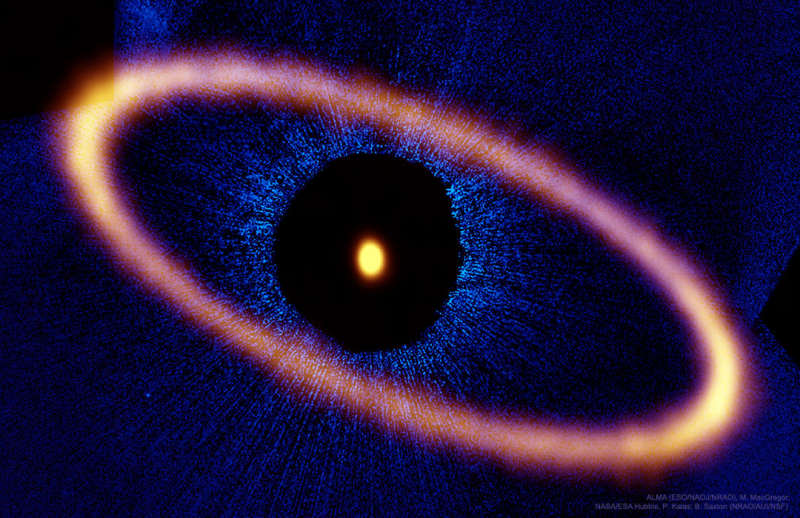Credit & Copyright: ALMA (ESO/NAOJ/NRAO),
M. MacGregor; NASA/ESA Hubble,
P. Kalas; B. Saxton (NRAO/AUI/NSF)
Explanation:
Why is there a large ice ring around Fomalhaut?
This interesting star --
easily visible in the night sky -- lies only about 25
light-years away and is known to be orbited by at least one planet,
Dagon,
as well as several inner dust disks.
More intriguing, perhaps, is an
outer ring,
first discovered about 20 years ago, that has an unusually sharp inner boundary.
The featured
recent image by the
Atacama Large Millimeter Array (ALMA)
shows this outer ring with complete and unprecedented detail -- in pink -- superposed
on a
Hubble
image of the Fomalhaut system in blue.
A leading theory holds that this ring resulted from numerous
violent collisions
involving icy comets and
planetesimals, the
component objects of planets,
while the ring boundaries are caused by the
gravity of yet unseen planets.
If correct, any interior planets in the
Fomalhaut system are likely being continually pelted by large meteors and comets
-- an onslaught last seen in
our own planetary system
four billion years ago in an episode called the
Late Heavy Bombardment.
Free Download:
The 2018 APOD Calendar
1999 2000 2001 2002 2003 2004 2005 2006 2007 2008 2009 2010 2011 2012 2013 2014 2015 2016 2017 2018 2019 2020 2021 2022 2023 2024 2025 |
Yanvar' Fevral' Mart Aprel' Mai Iyun' Iyul' Avgust Sentyabr' Oktyabr' Noyabr' Dekabr' |
NASA Web Site Statements, Warnings, and Disclaimers
NASA Official: Jay Norris. Specific rights apply.
A service of: LHEA at NASA / GSFC
& Michigan Tech. U.
|
Publikacii s klyuchevymi slovami:
Fomalhaut - Fomal'gaut
Publikacii so slovami: Fomalhaut - Fomal'gaut | |
|
Sm. takzhe:
| |
